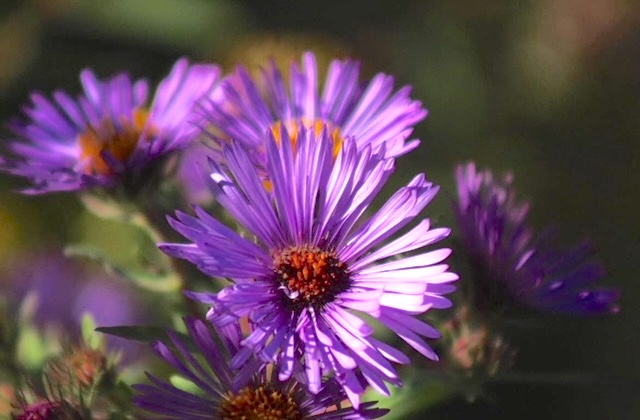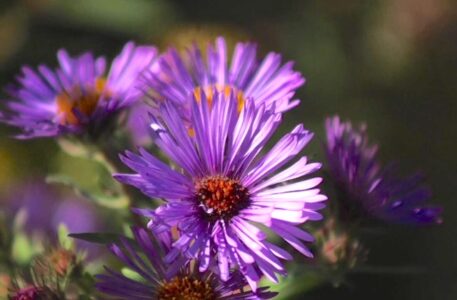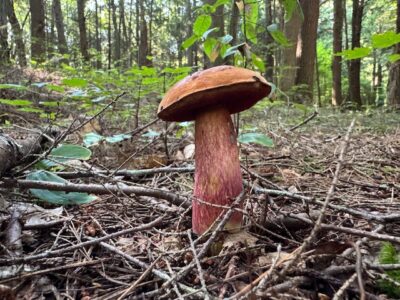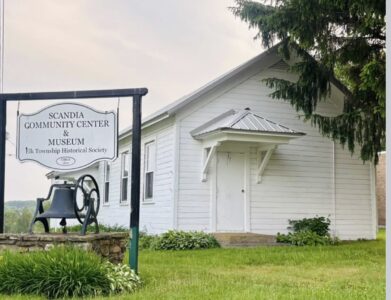Time for second spring

Photo by Taylor Brennan A New England Aster is pictured.
- Photo by Taylor Brennan A New England Aster is pictured.
- A two-colored bolete is pictured.
From then on, I found myself looking for signs of a second spring during this transitional time between the end of summer and beginning of fall. I always viewed this cluster of colorful months as a symbol for letting go, change, and the end of life for a leaf. However, after my friend’s short but mind-changing comment, I started to notice patterns that we also experience in the earlier months of the year.
The thought of flowers in a field may bring our memories back to the months of April through June, when we reach the peak of spring. Cow Parsley, trilliums, daffodils, and Jack-in-the-Pulpit are just a few that show us their beauty earlier in the year. However, as I gain more knowledge about wildflowers and where they grow, late August turns into yet another blossoming frenzy for these plants to get their last chance at color before winter comes. While Cow Parsley blooms during spring, a look-alike replacement makes its presence known four months later, in August and September. Queen Anne’s lace is another tall, white blossoming wildflower that can remind us that all seasons are connected.
We also see other types of plants like the yellow shimmer of goldenrod, coupled with the contrast of pink from Joe Pye Weed. Colors of blues and purples come into bloom during this time – tiny flowers with yellow pollen-filled centers known as New England Asters. Colorful flowers are not for springtime only, for I have seen how this dazzling array of colors once again catches my attention at the end of summer.
Late summer, as my friend puts it, is the “peak of mushroom season.” On our walks, she has shown me some of the coolest-looking fungi I have seen. One to look out for during this time of year is called the Two-colored Bolete (Baorangia bicolor). This short and stumpy mushroom can be identified by its stark red cap, combined with its yellow stem and polypore underneath. Many of us recognize the fish-gill pattern seen on the underside of mushrooms, but there is another type to search for. Polypore mushrooms have small ‘pores’ instead of layered gills, giving these fungi a fuller look. This is a favorite of mine to search for in the fall time, when weather is getting cooler and moisture is on the rise, creating the perfect conditions for mushroom growth. This bolete mushroom is special. When you touch or break it, the bruising it experiences turns yellow flesh into green or blue. It is fascinating to watch this changing of colors right before your eyes. These color-changing mushrooms are found in small clusters around oak trees in the late summer until October.

A two-colored bolete is pictured.
Another mushroom to find this fall is appropriately named the Purple-gilled Laccaria (Laccaria ochropurpurea). As the name states, this fungus has incredible purple coloring in its gills. Found only in the fall, this hidden beauty comes across as a 3-inch diameter white mushroom, a curved stem, and can be found in open wooded areas. If you take a closer look, you will notice a deep purple on the hymenium, also known as the underside where gills grow. This involves either getting on your hands and knees in the dirt, simply plucking it from the ground to investigate the hymenium, or using a stick to maneuver the mushroom. This wide range of color quietly growing on the ground and decaying tree stumps is waiting to be discovered. From reds and yellows to whites and purples, the world of mushrooms keeps me excited for the next species I stumble across in the forest during this time of year.
Autumn circles back to the behavior of animals as well, specifically birds. We know that birds migrate to their summer breeding grounds in the springtime, but many of us forget about the migration they endure to return to their winter homes. After Labor Day, many of us are ready to put away the summer decorations, start cleaning up our gardens, and put away hummingbird feeders, believing that summer is over. Migration for birds is just beginning at this time, typically peaking in September and October. Keeping those birdfeeders out for a few more weeks can help birds get that last bit of energizing food and nutrition they need before traveling to a warmer place.
As our seasonal calendar moves through time, I see echoes of springtime as the sun rises later in the morning, while it sets earlier in the evening. Although the day inches shorter minute by minute, I see springtime from the colors I see in fields and forests down to the timing of our sunrise and sunset. This causes me to dress in layers, making room for warmer weather that comes hours after a chilly morning, much like a March or April day would be. We will see the return of gentle frosts covering our landscapes, bringing us back to those chilly spring mornings we remember so many months ago.
Audubon Community Nature Center builds and nurtures connections between people and nature. ACNC is located just east of Route 62 between Warren and Jamestown. The trails are open from dawn to dusk and birds of prey can be viewed anytime the trails are open. The Nature Center is open from 10 a.m. until 4:30 p.m. daily except Sunday when it opens at 1 p.m. More information can be found online at auduboncnc.org or by calling (716) 569-2345.




